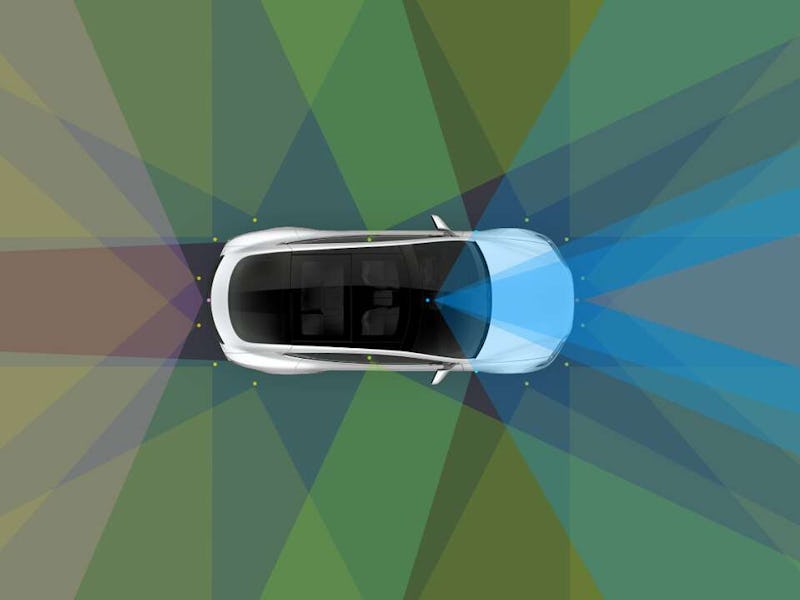Tesla Autopilot: Elon Musk outlines big year for full self-driving updates
The company's semi-autonomous driving system will receive big boosts.

Tesla's semi-autonomous Autopilot system is about to have a big year of updates, CEO Elon Musk suggested in comments this week.
The company's fleet of electric vehicles has been designed since October 2016 to one day support fully autonomous driving, through a series of computer and software updates as the technology develops. On Thursday, Musk declared via Twitter that the system would detect traffic lights and stop signals soon, while later this year it's set to release a "reverse summon" feature that would drop people off before autonomously finding a parking spot.
It's the latest in a series of steps toward Musk's vision of a fully autonomous car, one that can drive itself from point to point without any human intervention. Beyond enabling drivers to take a nap behind the wheel, the feature could enable cars to autonomously earn money for their owners by joining a robo-taxi service and ferrying passengers around. Musk, known for his ambitious timelines, has suggested this vision could be ready from a technical standpoint as soon as this year (legislation is another matter).
Tesla currently sells two tiers of semi-autonomous driving systems. The first is Autopilot, which comes included with every new Tesla and enables features like autonomous braking and steering to stay in a lane. A "full self-driving" tier comprises a software and computer upgrade, and currently covers features like:
- Navigate on Autopilot, where the car exits the highway at the correct exit depending on the inputted destination.
- Automatic lane changes during highway driving.
- Summon, to find a driver in a parking lot.
- Autopark, for reversing into parallel and perpendicular spaces.
All these features currently require human oversight. The upgrade includes the new "Hardware 3" computer in cases where the vehicle does not already have the upgraded computer. This was announced in August 2018 and packs a processor 10 times faster than the former Nvidia chip. Tesla currently charges $7,000 for the package, available alongside and after the car's purchase, but this is set to increase as the feature list expands.
Here is what we know about how all this will change in the coming year:
Traffic lights and stop signals
The vehicles are expected to receive the ability to detect traffic lights and stop signals, acting appropriately for the situation.. While the current system is relatively adept at slow speed maneuvers like Summon and high-speed maneuvers like highway driving, this feature could help plug the gap in medium speed drives and take a step closer toward full autonomy.
This feature was uncovered in March 2019 by a car hacker by the name "greentheonly." In March 2020, a Twitter account called "Out of Spec Motoring" showed a Model 3 running early access software stopping autonomously at red lights.
Musk announced on April 3 that the feature would roll out in the United States within a few weeks, before rolling out worldwide in the third quarter of 2020.
Reverse summon
This feature is expected to help the car drop off a driver near their location, then autonomously park themselves. If it's anything like the current "Summon" system, users will be able to control it via the Tesla smartphone app.
Musk referred to this feature back in January 2016 with the slightly less catchy title "unsummon." Musk announced this week that "Reverse Summon" would launch later this year.
A rewrite of the Autopilot system
In a January 2020 appearance on The Third Row podcast, Musk explained that Tesla was undertaking "a significant foundational rewrite in the Tesla Autopilot," where the "neural net is absorbing more and more of the problem." In other words, the artificial intelligence powering the system is taking on more of the challenge when it comes to full self-driving.
A new video of this neural net system in action, as spotted by Electrek, shows how the system interprets the input from these cameras:
Musk suggested that these foundational changes would happen before "Reverse Summon" could launch, making it a project for this year.
Robo-taxi service
Tesla's ambitious robo-taxi service, like Uber but without any drivers, could reach a feature-complete state this year. The system is expected to let users add their car to a fleet when not in used, during hours specified by the user, while passengers hail rides through an Uber-like app. The car owner is expected to receive a cut of the fares.
On Sunday, Musk wrote on Twitter that the feature could be ready as early as this year. The big question, Musk explained, would be whether regulators approve the system for full use.
Higher price
Tesla's website explains that the full self-driving package currently costs $7,000, but this will rise as the feature list increases in length. With all the above factored in, it's perhaps to be expected that Tesla considers this the right year to bump the price up again.
The next price jump could take place in July. On April 3, Musk mentioned July 1 as a potential date:
The Inverse analysis
If Musk can deliver, it looks set to be an impressive year for full self-driving.
The project has suffered from missed deadlines in the past. A planned cross-country autonomous drive in 2017 failed to materialize. An ambitious target to release a feature-complete version of full self-driving before the end of 2019 also passed by. Tesla is not alone in this situation, as the whole industry has come to grips with the sheer size of the task for delivering full autonomy.
But even if Tesla fails to deliver on its more ambitious targets, improvements like "Reverse Summon" and stopping at red lights are real-world improvements that will benefit existing drivers and enhance the user experience.